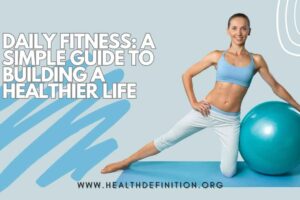
Physical fitness is more than just having a toned body or the ability to lift heavy weights. It’s about achieving overall health and well-being through a balanced combination of different fitness components. Understanding these components is essential for designing an effective workout routine that improves your health, enhances your performance, and reduces the risk of injury. In this article, we’ll explore the main components of physical fitness, their benefits, and how to incorporate them into your lifestyle.
Cardiorespiratory Endurance
What is it?
Cardiorespiratory endurance refers to the ability of the heart, lungs, and blood vessels to supply oxygen to working muscles during prolonged physical activity. It’s an indicator of how efficiently your cardiovascular and respiratory systems work together.
Why is it important?
Good cardiorespiratory endurance enhances overall stamina and energy levels. It reduces the risk of chronic diseases such as heart disease, diabetes, and hypertension. Additionally, it boosts mental health by reducing stress and anxiety.
How to improve it?
- Aerobic Exercises: Engage in activities like running, cycling, swimming, or brisk walking for at least 150 minutes per week.
- High-Intensity Interval Training (HIIT): Short bursts of intense exercise followed by rest periods enhance cardiovascular capacity.
- Consistency is Key: Regularly engaging in cardio activities ensures continuous improvement.

Muscular Strength
What is it?
Muscular strength is the maximum amount of force a muscle or muscle group can generate during a single contraction. It is crucial for daily tasks such as lifting, pushing, or pulling objects.
Why is it important?
Increased muscular strength improves body posture, reduces the risk of injuries, and enhances overall body mechanics. It also boosts metabolic rate, aiding in weight management.
How to improve it?
- Weight Training: Incorporate exercises like bench presses, squats, deadlifts, and overhead presses using weights.
- Bodyweight Exercises: Push-ups, pull-ups, and planks are effective for building strength.
- Progressive Overload: Gradually increase the weight or resistance to continuously challenge muscles.
Muscular Endurance
What is it?
Muscular endurance is the ability of a muscle or group of muscles to perform repeated contractions over a period without fatigue. It plays a key role in sports and daily activities that require sustained effort.
Why is it important?
Enhanced muscular endurance improves posture, reduces fatigue, and supports joint stability. It is particularly beneficial for athletes and individuals with physically demanding jobs.
How to improve it?
- Circuit Training: Perform multiple exercises targeting different muscle groups in succession with minimal rest.
- High Repetitions with Low Weights: Using lighter weights with more repetitions increases muscular endurance.
- Functional Exercises: Incorporate movements that mimic daily activities to enhance endurance.
Flexibility
What is it?
Flexibility is the range of motion available at a joint. It depends on the elasticity of muscles, tendons, and ligaments.
Why is it important?
Improved flexibility enhances movement efficiency, reduces muscle stiffness, and decreases the risk of injuries. It also helps in maintaining good posture and alleviates muscular pain.
How to improve it?
- Static Stretching: Hold stretches for 15-30 seconds after a workout to enhance flexibility.
- Dynamic Stretching: Perform controlled, active movements to prepare muscles before a workout.
- Yoga and Pilates: These practices incorporate stretching and balance, promoting flexibility and relaxation.
Body Composition
What is it?
Body composition refers to the proportion of fat and non-fat mass (muscle, bone, and water) in your body. It’s a key indicator of health and fitness levels.
Why is it important?
Healthy body composition reduces the risk of chronic diseases like obesity, type 2 diabetes, and cardiovascular disorders. It also influences physical appearance and self-esteem.
How to improve it?
- Balanced Diet: Consume a diet rich in lean proteins, complex carbohydrates, and healthy fats.
- Regular Exercise: Combine cardio and strength training to reduce body fat and increase muscle mass.
- Hydration and Sleep: Proper hydration and adequate sleep are crucial for maintaining a healthy body composition.
Agility, Balance, and Coordination
What are they?
- Agility: The ability to change direction quickly and efficiently.
- Balance: Maintaining body stability while stationary or moving.
- Coordination: Harmonious functioning of body parts to perform complex movements.
Why are they important?
These components are essential for athletic performance and daily activities that require quick reflexes and precise movements. They also reduce the risk of falls and injuries.
How to improve them?
- Agility Drills: Ladder drills, cone drills, and plyometric exercises enhance agility.
- Balance Exercises: Practice single-leg stands, stability ball exercises, and yoga poses.
- Coordination Drills: Activities like dancing, playing catch, and complex body movements improve coordination.
Speed and Power
What are they?
- Speed: The ability to move quickly from one point to another.
- Power: The ability to exert maximum force in a short period.
Why are they important?
Speed and power are crucial for athletic performance, especially in sports requiring rapid movements. They also enhance overall functional fitness and agility.
How to improve them?
- Sprint Training: Short-distance sprints enhance speed and explosive power.
- Plyometric Exercises: Jump squats, box jumps, and medicine ball throws improve power.
- Strength and Conditioning: Combine weight training with explosive movements for maximum power development.
Conclusion
Physical fitness is a multi-dimensional concept encompassing various components such as cardiorespiratory endurance, muscular strength, muscular endurance, flexibility, body composition, agility, balance, coordination, speed, and power. By understanding and incorporating each component into your fitness routine, you can achieve overall health, enhance performance, and reduce the risk of injuries.
Whether you’re an athlete aiming for peak performance or someone looking to improve daily functionality, a balanced fitness regime is essential. Start by assessing your current fitness level, set realistic goals, and gradually include exercises targeting each component. With consistency and dedication, you’ll not only improve your physical fitness but also enhance your quality of life.

SEO Tips for “Components of Physical Fitness”
- Use relevant keywords such as “components of physical fitness,” “cardiorespiratory endurance,” “muscular strength,” and “flexibility.”
- Incorporate long-tail keywords like “how to improve physical fitness components” or “importance of body composition.”
- Optimize meta tags, alt texts, and internal linking to related fitness articles for better SEO performance.
With a well-structured approach and the right mix of fitness components, you can achieve a balanced and healthy lifestyle.
FAQs about components of physical fitness
-
What are the main components of physical fitness?
The main components of physical fitness are:- Cardiorespiratory Endurance – The ability of the heart and lungs to supply oxygen during sustained physical activity.
- Muscular Strength – The amount of force a muscle can produce with a single maximal effort.
- Muscular Endurance – The ability of a muscle to continue to perform without fatigue.
- Flexibility – The range of motion available at a joint.
- Body Composition – The relative amount of muscle, fat, bone, and other vital parts of the body.
-
Why are these components important for overall health?
These components contribute to overall health by improving cardiovascular health, increasing muscle and bone strength, enhancing flexibility, reducing the risk of chronic diseases, and maintaining a healthy weight. -
How can I improve each component of physical fitness?
- Cardiorespiratory Endurance: Engage in aerobic exercises like running, cycling, or swimming.
- Muscular Strength: Perform resistance training such as weightlifting.
- Muscular Endurance: Do repetitive exercises like bodyweight squats or push-ups.
- Flexibility: Incorporate stretching routines or practices like yoga.
- Body Composition: Maintain a balanced diet and combine cardio and strength training.
-
How often should I work on each component?
- Cardiorespiratory Endurance: At least 150 minutes of moderate-intensity or 75 minutes of high-intensity exercise per week.
- Muscular Strength and Endurance: 2-3 days per week, targeting all major muscle groups.
- Flexibility: At least 2-3 times per week, ideally after warming up.
- Body Composition: This is maintained through a combination of regular exercise and a healthy diet.
-
Can one component affect the others?
Yes, improving one component can positively influence others. For example, increasing muscular strength can enhance endurance, and better cardiovascular fitness can aid in maintaining a healthy body composition.
Bullet point about Components of Physical Fitness:
- Cardiovascular Endurance – The ability of the heart and lungs to supply oxygen to the body during sustained physical activity.
- Muscular Strength – The amount of force a muscle can produce with a single maximal effort.
- Muscular Endurance – The ability of a muscle to continue to perform without fatigue.
- Flexibility – The range of motion available at a joint.
- Body Composition – The ratio of fat to lean mass (including muscle, bone, and water) in the body.
- Balance and Coordination – The ability to maintain control of body movements and position.






